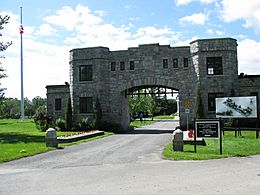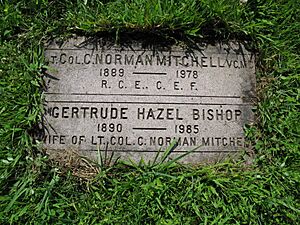National Field of Honour facts for kids
The National Field of Honour is a special military cemetery in Pointe-Claire, Quebec, Canada. It's a place where Canadian and Allied Veterans, along with their families, can be buried. The Last Post Fund, a charity, takes care of this important site.
On June 8, 2007, the National Field of Honour became a National Historic Site of Canada. This means it's recognized as a very important place in Canadian history.
Contents
- History of the National Field of Honour
- Important Memorials and Circles
- The Gate of Remembrance: Cemetery Entrance
- Currie Circle: Honoring Sir Arthur Currie
- The Flagstaff: A Tall Gift
- Commonwealth War Graves Memorial: Quebec Memorial
- Air Force Memorial: For Air Veterans
- Army Memorial: For Soldiers
- Navy Memorial: For Sailors
- De Salaberry Circle and Veterans' Memorial
- D'Urban Circle: Oldest Graves
- Jewish Section and Monument
- The Peace Circle: For Peacekeepers
- The Water Garden and Columbarium
- Future Plans for the Cemetery
- Notable burials
History of the National Field of Honour
The National Field of Honour was started by the Last Post Fund. This charity was founded by Arthur Hair in 1909. The Last Post Fund helps make sure every Veteran gets a respectful funeral and burial. They also ensure Veterans receive a military gravestone, even if they don't have much money.
The cemetery was officially opened on September 21, 1930. By 2010, over 22,000 people had been buried here. A unique thing about this cemetery is that all the headstones are flat on the ground. This shows that all Veterans, whether they were Generals or Privates, are equal here. The Commonwealth War Graves Commission has registered 16 war graves from World War II at this site.
You can visit the National Field of Honour from Monday to Friday, 8am to 4pm. On weekends, you can still walk around the grounds. Each street in the cemetery is named after a famous Canadian Veteran. There are also three special circles that honor different war heroes. A new Columbarium has been added for Veterans' ashes. There's also a peaceful water garden with benches for visitors to relax.
Important Memorials and Circles
The Gate of Remembrance: Cemetery Entrance
The main entrance to the National Field of Honour is through the Gate of Remembrance. It looks like a medieval arch with two towers. One tower has a small chapel inside. This gate was built in 1937 and cost $11,850. The city of Pointe-Claire donated $5,000. It took 13 weeks to build.
The Gate of Remembrance honors all those who gave their lives for their country. The architect was Harold J. Doran.
Currie Circle: Honoring Sir Arthur Currie
Currie Circle is named after Sir Arthur Currie. He led the Canadian Corps in World War I. Later, he became the head of McGill University. He was also president of the Last Post Fund from 1924 to 1932. He is buried at Mount Royal Cemetery.
The Cross of Remembrance stands in the middle of Currie Circle. In 1947, Arthur Hair, who founded the Last Post Fund, was the first person buried near this cross. This area is called the Directors' Circle. It is reserved for Last Post Fund officials.
The Flagstaff: A Tall Gift
A very tall metal flagstaff stands 22 meters (73 feet) high. It was a gift from a Canadian Steamship Line. The Dominion Bridge Company put it up in 1930.
Commonwealth War Graves Memorial: Quebec Memorial
The Commonwealth War Graves Commission (CWGC) was started in England in 1917. It marks and cares for the graves of Commonwealth soldiers who died in the two World Wars. They also build memorials for those with no known grave.
The Quebec Memorial has two granite blocks. It honors Canadian soldiers from both World Wars who were buried in Quebec. Their graves could no longer be marked or cared for. It lists the names of 49 soldiers from World War I and 43 from World War II.
Air Force Memorial: For Air Veterans
This monument was given in 2003 by Flight Lieutenant Howard Ripstein. He was a former director of the Last Post Fund in Quebec. It's a concrete propeller. It remembers Veterans from the Canadian and Allied Air Forces.
Army Memorial: For Soldiers
This memorial has two large six-inch cannons. It honors Canadian and Allied soldiers who died for their country. The Canadian Army donated it in 1999.
An anchor serves as a memorial for Canadian and Allied sailors. The Canadian Forces' Longue Pointe Garrison donated it in 1998.
De Salaberry Circle and Veterans' Memorial
This circle is named after Lieutenant Colonel Charles de Salaberry. He was a French-Canadian nobleman. He led Canadian troops during the War of 1812. His troops stopped American forces at the Battle of the Chateauguay in 1813.
In the middle of this circle is the Veterans' Memorial. It honors all Canadian military men and women. This includes those who died in World War I, World War II, and the Korean War.
D'Urban Circle: Oldest Graves
D'Urban Circle holds the oldest graves in the National Field of Honour. These are soldiers who fought in wars as far back as the 1700s. This includes the Fenian Raids, the Napoleonic Wars (like the battle of Waterloo), and the War of 1812.
These Veterans were first buried at the Papineau Military Cemetery in Montreal. That cemetery was used by British Forces from 1814 to 1869. In 1944, the cemetery had to be moved for the Jacques Cartier Bridge. About 1,797 burials were moved. This was a huge task for the Last Post Fund.
It was hard to identify everyone because records were old. Luckily, in May 1944, Sydney Ham copied all the information from the headstones. He did a lot of research to create a full list of those buried. His work helped save the memory of these Veterans. All the remains and headstones were moved with military honors. The transfer finished on July 21, 1944.
At the center of this circle is a tall stone monument called an obelisk. It honors Sir Benjamin D'Urban. He was a British General who died in Canada in 1849. He fought in the Napoleonic Wars. This obelisk was moved here from the Papineau Military Cemetery in 1944. It is the largest monument at the National Field of Honour.
Jewish Section and Monument
This part of the National Field of Honour was set aside for Jewish Veterans. It follows the rules of the Jewish faith for burials. The monument here honors Canadian and Allied Jewish Veterans who died for their country.
The Peace Circle: For Peacekeepers
The Peace Circle was dedicated in 1997. This was after Canada started to include peacekeepers as Veterans. The Peace Monument was designed by Jean Bernard. He was a World War II Royal Canadian Air Force Veteran. A white dove sits on a pink granite block. The dove stands for peace. The words "Paix & Peace" are carved into the stone.
The Water Garden and Columbarium
The water garden helps make the area peaceful. It has beautiful water lilies in the summer. There are benches for visitors to enjoy the view.
The Columbarium is a new addition. It provides spaces for the ashes of Canadian Veterans and their spouses. It has over 800 spots for urns. It is an impressive monument with benches for visitors to sit and relax.
Future Plans for the Cemetery
There are plans to keep improving and expanding the National Field of Honour. For example, there are plans to build a new reception center. This center will use modern technology to better serve visitors. Canada still has many Veterans from World War II, the Korean War, and other conflicts. The cemetery will continue to honor them.
Notable burials
- Lieutenant-General Sir Benjamin d'Urban, GCB, KCH, KCTS
- Jack Gelineau BEM
- Private Leo Major DCM and Bar
- Lieutenant Colonel Coulson Norman Mitchell VC MC



